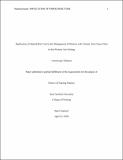Application of the Opioid Risk Tool in the Management of Patients with Chronic Non-Cancer Pain in the Primary Care Setting
Author
Dadson, Armstrong
Abstract
Problem: The opioid epidemic in the United States is increasing at an alarming rate. Many people lose their lives every day for abusing or misusing prescription opioids. Patients can be screened for risks of opioid abuse or misuse prior to being prescribed opioids. This DNP project was planned, implemented, and evaluated by a student-led quality improvement team who implemented the Opioid Risk Tool in one primary care clinic with the goal of identifying patients at risk for opioid-related aberrant behaviors. Methodology: The DNP student led a team of five health care staff in a local clinic to use the Opioid Risk Tool. Five PDSA cycles were completed during the implementation phase. Data was tracked using run charts. Results: During the implementation phase, 378 patients were seen in the clinic, with 165 (44%) of those patients screened for potential aberrant behaviors related to opioid use. Of the 165 patients screened, 101 (61%) needed opioid therapy for the treatment of noncancer-related chronic pain, with 37 patients (22%) identified as medium-to-high risk for opioid misuse. The goal of the project was to screen at least 20 (48%) appropriate patients each week; however, an average of 18 (44%) patients were screened weekly. The median percentage of patients screened with the Opioid Risk Tool was 44%, with weeks seven, eight, and nine being above the median of 44%. Conclusion: The DNP project student leader recommends that primary care practices implement a policy requiring primary care providers to use a validated tool, such as the Opioid Risk Tool, to screen every patient with chronic pain unrelated to cancer before opioid treatment is initiated.
Date
2020-04-30
Citation:
APA:
Dadson, Armstrong.
(April 2020).
Application of the Opioid Risk Tool in the Management of Patients with Chronic Non-Cancer Pain in the Primary Care Setting
(DNP Scholarly Project, East Carolina University). Retrieved from the Scholarship.
(http://hdl.handle.net/10342/8482.)
MLA:
Dadson, Armstrong.
Application of the Opioid Risk Tool in the Management of Patients with Chronic Non-Cancer Pain in the Primary Care Setting.
DNP Scholarly Project. East Carolina University,
April 2020. The Scholarship.
http://hdl.handle.net/10342/8482.
June 29, 2024.
Chicago:
Dadson, Armstrong,
“Application of the Opioid Risk Tool in the Management of Patients with Chronic Non-Cancer Pain in the Primary Care Setting”
(DNP Scholarly Project., East Carolina University,
April 2020).
AMA:
Dadson, Armstrong.
Application of the Opioid Risk Tool in the Management of Patients with Chronic Non-Cancer Pain in the Primary Care Setting
[DNP Scholarly Project]. Greenville, NC: East Carolina University;
April 2020.
Collections
Related items
Showing items related by title, author, creator and subject.
-
Implementation of Non-Opioid Protocol to Reduce Opioid Use in an Adult Outpatient Clinic
Charles, Angelica (2022-07-27)The United States is in an opioid epidemic due to increased abuse of prescription opioids and increased access to illicit opioids. Non-pharmacological and adjuvant therapies in managing chronic lower back pain will help ... -
Co-Prescribing Naloxone Policy for Chronic Pain Patients on Opioid Therapy
Dillon, Margaret (2020-07-29)Opioid misuse and overdose related deaths are an escalating problem in the nation that crosses all gender, age, sociologic, economic, and race barriers. A private practice clinic treating chronic pain with opioid medication ... -
Exposure to medicines in the family medicine cabinet: is it a harbinger of later opioid dependence?
Egan, Kathleen L. (2020)

